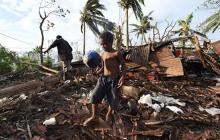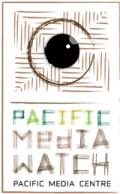
AUCKLAND (RNZI/ Pacific Media Watch): A photographer who's spent the past few years travelling the Pacific in an attempt to document the effects of climate change, says the rest of the world seems to know little about the region's plight.
Vlad Sokhin has travelled to at least 10 of the region's countries and territories for his project, "Warm Waters", documenting sea level rise, changing weather patterns, and food and water shortages.
At a recent exhibition of his work in New Zealand's capital, Wellington, Mr Sokhin told Jamie Tahana he hopes his work will expose what's going on in some of the most isolated parts of the world in the international arena.
VLAD SOKHIN: My new project, called "Warm Waters," is about climate change in the Pacific; sea level rise, deforestation, coastal erosions, cyclones, water shortage, and, you know, food security. It's about communities that live on the front line of climate change, and the aim of this project is to travel to cover all the Pacific. I want to travel from Alaska down to New Zealand and maybe even Antarctica if I can get there and cover the whole Pacific area. It's never been done before, there is some work on sea level rise in several Pacific countries done by some other photographers, but no one's ever covered the whole scale of climate change in this region. It's kind of the biggest region, if you open Google Maps and just put 'the Pacific' it's almost half of the planet, right? It's the largest ocean, and there's so many people living in it and there's not much coverage. You know, only a couple of times I met a couple of photographers while working in all these countries. I've covered most of the South Pacific and North Pacific, I've been everywhere in Micronesia, I've covered all Melanesia and half of Polynesian countries.
JAMIE TAHANA: Remote places, how challenging is it to get around them?
VS: It's very challenging, some places there's like one flight a week, places like Tokelau, they don't even have an airport so it took me two months to apply for a visa, then when I got it the boat didn't go so two weeks extra waiting in Samoa, and then when I got there finally I managed to cover everything but then the boat didn't come to pick me up on time, so I had to change my tickets to New Zealand -- so yeah, it's kind of challenging. There was place that I arrived and then went to get to Ulithi atoll in Federated States of Micronesia. I came the day before the flight -- and there's like one flight every two weeks -- and when I got to the airport I realised they wouldn't board me because I needed special permission from the island and I couldn't get it because their office was closed, so I had to charter a plane two days later to get there. So it's kind of challenging, but you know, I'm getting there.
JT: How do you fund it?
VS: Ah that's the most difficult part. I just get assignments, that's what I do. So I let people know that I'm in the area, I work with many international organisations, with a bunch of UN agencies, I work with the World Bank, I work with several NGOs in New Zealand, in Australia, and some media outlets as well. So I jump from assignment-to-assignment sometimes staying longer in the country on my own, and that's how I manage because I don't have any grant.
JT: And you are documenting the effects of climate change and cyclones and all that. What have you found? What is the situation?
VS: The situation is quite difficult for these Pacific communities. Imagine someone tells you that there was a big cyclone and it destroyed all coconuts, for example. What would a person think that had never been to a Pacific island? Like, 'they can live without coconuts.' But the cyclone destroyed all coconuts and then they don't have their rain catching, like water tanks, they're blown away. So how would these people survive? They don't have any source of fresh water after that, so they rely on international help. Or, for example, in Kiribati when the high tide comes and they have these traditional houses, it was a tradition before to tie up their kids so they don't run away. But now they are afraid that these kids will drown. During the last three months I visited ten Pacific countries, and three of them -- Kiribati, Samoa and Niue -- had problems with fresh fish. There is no fish because the weather patterns have changed, so fishermen are not going out to fishing, and I've seen crazy scenes when a fishing boat approaches the shore, the families send their fastest and youngest boys to swim to meet the fishermen to grab fish from the boat while they're still approaching the shore and then they swim back and then they pay for their fish because if you're fast you get their fish because there's a big demand. You know, fish are scarce now.
JT: So a very serious situation with sea level rise and all the other effects of it?
VS: Yeah, yeah it is serious. I don't say that these islands disappear, it is definitely not happening now, but it might happen soon. But except for sea level rise there are many, many other after effects of it.
This work is licensed under a Creative Commons Attribution-NonCommercial 3




